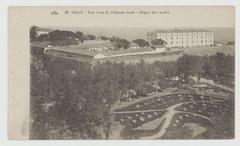Hassan Pasha Mosque: Visiting Hours, Tickets, and Historical Significance in Oran, Algeria
Date: 14/06/2025
Introduction
The Hassan Pasha Mosque, also known as the Grande Mosquée d’Oran, is a monumental landmark reflecting Oran’s Ottoman heritage and Islamic history. Erected between 1796 and 1797 under the direction of Sidi Hassan Pasha, the Ottoman Bey of Oran, the mosque commemorates the city’s liberation from centuries of Spanish rule. Today, it stands not only as an architectural marvel combining Ottoman and Maghrebi styles, but also as a living monument to Oran’s complex cultural evolution. This comprehensive guide explores the mosque’s history, architectural features, cultural importance, visiting hours, ticketing, accessibility, travel tips, and nearby attractions.
For travelers seeking a deeper understanding, resources such as Lonely Planet, HalalTrip, and Trek Zone provide additional information.
Table of Contents
- History and Foundation
- Architectural Features & Symbolism
- Cultural and Religious Significance
- Role During Colonial and Post-Colonial Periods
- Visiting Information: Hours, Tickets, Accessibility
- Preservation and Restoration Efforts
- Visitor Etiquette and Practical Tips
- Nearby Attractions in Oran
- FAQs
- References
History and Foundation
Commissioned in the wake of Oran’s recapture by the Ottomans from the Spanish in 1792, the Hassan Pasha Mosque was constructed to reassert Islamic and Ottoman identity in the region. The mosque’s marble inscription, now preserved at the Oran Museum, celebrates its founding as a symbol of resilience, faith, and victory. The funding reportedly came in part from ransoms paid for the release of Christian captives, underlining the region’s complex socio-political landscape in the late 18th century (Lonely Planet; Trek Zone).
Architectural Features & Symbolism
Site Placement and Urban Context
Nestled in the Sidi El Houari district, the mosque is a defining feature of Oran’s old city. Its strategic location integrates it with the urban environment, in keeping with Ottoman tradition of placing major religious buildings at the core of civic life (Horizons.dz).
Design and Layout
- Plan: The mosque features a rectangular plan with a spacious, column-free prayer hall, enhancing acoustics and capacity.
- Minaret: Its octagonal, tile-adorned minaret evokes Ottoman stylistic elements, setting it apart from the square minarets typical of Maghrebi mosques (Trek Zone).
- Entrances: The main portal is richly decorated with geometric and floral motifs, Quranic inscriptions, and Kufic script (Academia.edu).
- Courtyard: A tranquil, arcaded courtyard surrounds a marble ablution basin, emphasizing ritual purity.
Interior Decoration
The prayer hall is adorned with carved wooden features, including the minbar (pulpit) and mihrab (prayer niche). Quranic calligraphy and intricate patterns in plaster and wood create an ambiance of spiritual contemplation (Horizons.dz).
Cultural and Religious Significance
The mosque has always served as a focal point for worship and religious education in Oran. Its founding, following the end of Spanish occupation, symbolized both religious resurgence and community resilience. Endowments (waqf) from the mosque’s inception provided for charitable works and ongoing maintenance, cementing its role as a center of social welfare and learning.
Role During Colonial and Post-Colonial Periods
Under French occupation, the mosque was temporarily repurposed before being restored to the Muslim community in 1833. Napoleonic emblems and historical inscriptions at the entrance testify to its layered history. Over time, the mosque remained the principal spiritual, educational, and community hub for Oran’s Muslims, and its significance only deepened following Algeria’s independence (HalalTrip).
Visiting Information: Hours, Tickets, Accessibility
Visiting Hours
- General Hours: The mosque is typically open to visitors outside the five daily prayer times, usually from 9:00 AM to 12:00 PM and 2:30 PM to 5:00 PM. Hours may vary on Fridays and religious holidays (Archiqoo).
- Current Status: As of 2010, the mosque has undergone periods of closure for conservation work. Always verify current visiting status through official tourism sites or Oran’s tourism office (Horizons.dz).
Tickets and Entry Fees
- Entry is generally free of charge.
- Donations are appreciated and help support ongoing maintenance.
- Costs for guided tours range from 500–1000 DZD ($4–$8 USD).
Accessibility
- Location: Central Sidi El Houari, easily reached on foot or by taxi from the city center.
- Mobility: Some areas have uneven surfaces and steps; wheelchair accessibility is limited.
- Facilities: Restrooms are available nearby; shops and cafés surround the mosque.
Guided Tours
- Offered in Arabic, French, and sometimes English, guided tours provide in-depth historical and architectural context.
- Book through local operators or at tourist information points.
Preservation and Restoration Efforts
Listed as a historic monument since 1952, the Hassan Pasha Mosque has been a focus of conservation. Major restoration in 2007, including international collaboration, addressed structural integrity and preservation of architectural details (Horizons.dz; Ibnbattutatravel.com). Ongoing community involvement, legal protections, and educational programs support its continued vitality.
Visitor Etiquette and Practical Tips
- Dress Code: Modest attire is required. Women should cover arms, legs, and hair; scarves are often provided at the entrance.
- Conduct: Maintain silence, respect worshippers, and remove shoes before entering the prayer area.
- Photography: Allowed in exterior and some interior areas without flash; always seek permission before photographing people.
- Best Visiting Time: Weekday mornings or afternoons are typically quieter.
Nearby Attractions in Oran
Enhance your visit by exploring these sites:
- Sidi El Houari District: Historic streets, Turkish baths, and Saint-Louis Church (Your Last Borders).
- Bey’s Palace: Ottoman palace with guided tours.
- Place du 1er Novembre: Central square with colonial-era architecture.
- Porte d’Espagne: Spanish Gate, a relic from Oran’s Spanish era.
- Fort Santa Cruz: Hilltop fortress with panoramic city views.
- Cathedral of the Sacred Heart: Now Oran’s public library.
- Ahmed Zabana National Museum: Showcasing Algerian history and archaeology (Wanderlog).
- Corniche and Beaches: Scenic coastal boulevard and popular beaches.
FAQs
Q: What are the Hassan Pasha Mosque’s visiting hours?
A: Generally 9:00 AM–12:00 PM and 2:30 PM–5:00 PM, but always check current status due to potential closures for conservation.
Q: Is there an entry fee?
A: No, entry is free; donations are appreciated.
Q: Can non-Muslims enter the mosque?
A: Yes, outside prayer times, provided visitors respect the dress code and customs.
Q: Are guided tours available?
A: Yes, in Arabic, French, and sometimes English; inquire at local tour operators.
Q: Is the mosque wheelchair accessible?
A: Accessibility is limited due to historic architecture and cobbled streets.
Q: What else can I see nearby?
A: Sidi El Houari’s historic sites, Bey’s Palace, Fort Santa Cruz, and Ahmed Zabana National Museum.
References
- Lonely Planet
- Trek Zone
- HalalTrip
- Horizons.dz
- Ibnbattutatravel.com
- Your Last Borders
- Wanderlog
- Archiqoo
- Academia.edu
- Harba-dz.com
- Grande Mosquée de Paris
- Algerieterredafrique.blogspot.com
Final Tips for Visitors
The Hassan Pasha Mosque is a cornerstone of Oran’s heritage—merging spiritual significance, Ottoman artistry, and Algerian resilience. Whether you are drawn by faith, history, or architecture, your visit promises rich rewards. For the most current information, consult official tourism resources and consider downloading the Audiala app for guided experiences, maps, and insider tips.


